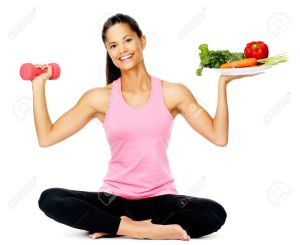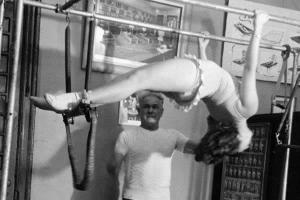Open any glossy magazine, flip to a random page and you’re likely to be bombarded by images of what a woman is supposed to look like, how she should get healthy, what she should feel about her physique, and instructions about how to nip, tuck, mold, embrace, shred, celebrate, burn, and transform her body into its perfect state. [1][2] The same can be found across movies, television, advertising, the internet, and in uncountable interactions with people who have internalized these values. This dizzying, kaleidoscopic whirlwind of beauty standards is terrifically contradictory, but the collective din of these judgments clog our culture and collude to hurt women. The second wave of feminists fought back against these voices, and in recent years we’ve seen new movements celebrate different body shapes, colors, sizes, and types in reaction against the mainstream norms. But the conversation underlying all these examples is still all over the map.
Let’s survey the landscape. A few years ago “strong/fit was the new skinny,” and then there came along #fitspiration, it’s thin twin, #thinspiration, and its cousin in desperate need of medical help, #proana. We witnessed the obsession and backlash around Lululemon’s #thighgapgate, and the reactionaries who claimed that anyone who actually had a thigh gap must be sick or photoshopped out of existence. Olympic athletes are attacked and then defended in a split second for their physiques, moms are shamed and celebrated for their workout bodies, young girls are bullied for their appearance, and the armies of the #curvy and the #skinny wage war across the battlefields of rap music and Instagram. But when the smoke clears, what are we really talking about here? How can we define our terms and place ourselves in a better relationship to these issues?
A human being can be healthy but not fit. They can be overweight and still healthy. A fit person can be beautiful but unhealthy. Or beautiful but still hate their body. Or disabled and strong. Or love themselves yet be unable to do the things they want to do. A person can have none, some, or all of these things.
In pursuit of clarity I’ve broken all these issues down into three categories: self-image, health, and ability.
___
SELF-IMAGE
This one’s simple. All bodies are beautiful.
The human form is a masterpiece of form and function, with just enough weird mystery and unplanned oddity to lend it constant fascination. Every body is unique, and there are infinite reasons to find each wondrous – worthy of love, care, and respect. This is every human’s birthright. Look with enough curiosity and you can find beauty in anyone, and probably learn more about yourself while you’re at it.
To think otherwise is prejudice, bigotry, and hate.
We all have our hangups about other bodies, and just like “everybody’s a little racist,” we’re all on our individual paths toward dismantling the prejudices we’ve inherited and learned along the way. But no discussion of these issues should allow for any form of body-shaming. We should all be held accountable for the damage we do in this regard.
___
HEALTH
One could say much on this vast issue; a cardiologist would have a legitimate perspective very different from a Structural Integrator or a Chiropractor. But as a Pilates instructor and movement educator I’ve got pretty strong views on what makes a person healthy.
All humans should have a positive relationship to movement. They should feel good about moving their bodies in various ways, build a kind and curious kinship with their own bodies and minds, master certain objective principles of coordination, initiation, comfort, and protection, and learn how to adapt to changing circumstances. These values can and should be applied to the entirety of each person’s life. There exist, of course, myriad schools of thought, specific concepts, and goals surrounding these core values – which is why there are so many wonderful types of fitness in the world today – but the underlying ideas listed above are true for every living human. We move to learn who we are, let go of who we’re not, and grow into the best versions of ourselves possible.
___
ABILITY
Joseph Pilates created his method for “…normal, healthy bodies…” [3]. Coming from a straight, white, male, German immigrant in the early 20th century, this is a pretty loaded statement and has spawned a wide range of interpretations. Today the Pilates spectrum ranges from Physical Therapy-based Pilates derivatives on one end to fad-based exercise classes, with Classical Pilates sitting somewhere in the middle.
None of these camps talk in any meaningful way about ability or ableism, or how “normal” applies to a Pilates practitioner.
Years ago I was fortunate to work at a studio whose clientele included a very high proportion of geriatric students. Some of these men and women had worked with Mr. Pilates himself back in the day, and had accrued an unique wealth of experience. Yet many also suffered serious physical and mental incapacities in the course of their long lives. Advanced osteoporosis, severe joint degeneration, strokes, amputations, spinal herniations, fusions, bifidas, and nerve damage affected many of these men and women. I was grossly underprepared to help such students, yet through working with these wonderful people I learned a great deal about the capabilities of the human body.
At this studio I regularly taught a delightful lady whom I’ll call Jane. [4] Jane was in her late 80’s – osteoporotic, double labral tears, vertigo, multiple 30%+ scoliotic curves, and had woken up from a six month coma just before I started teaching her. Although she had been cleared by her doctor to attempt Pilates in certain limited capacities, I was way out of my depth working with her and initially I went into our sessions with an extremely conservative plan. But this woman was simply unstoppable. Every diagnosis she had received, every assumption those around her saddled her with, every voice in her life tried to tell her that she was crippled, disabled, old, irrelevant, and broken. But she simply refused to listen. Within circumscribed exercises (standing Chest Expansion, standing Single Leg Springs, Side Bend with the Push Through Bar) Jane worked with unlimited passion, courage, humor, and strength. She never learned how to do a full Walkover or Going Up and Down, but she lived up to the fullest range of her body’s potential. Jane loved what Pilates helped her body to do and I was honored to assist her in doing so.
Success should not measured by an objective standard of ability. No two people need an identical workout, the same skills, or a single approach because they do not share the same goals, challenges, or lifestyles. Ability should instead be measured by positive steps taken toward what a person wishes to accomplish. It is highly personal, and a helpful teacher should align their teaching tools to best serve these needs, not their own or the larger judgments of society.
Our culture will continue to force its unpacked, problematic values on us all, and women – who make up the vast majority of Pilates students – will continue to suffer the most. These problems will be brought into the Pilates studio by well-meaning teachers, ambitious students, and self-proclaimed experts. Ignorance will perpetuate myths, but Pilates won’t shred belly fat, rekindle a bad husband’s lust, or take back all the hurtful, body-shaming things people have said. Pilates can, however, be a bridge beyond these reductive notions of what makes a woman worthwhile, well, and wonderful. With careful support and constant reevaluation of its own expectations and judgments Pilates can cultivate within the individual a better relationship to self, health, and ability.
___
1. I’m a privileged, cis, able white man and normally I would not have any business talking about this subject – my role would be to support the female-identified people around me by listening and helping as they wished. But I’m a Pilates instructor and movement educator, so I have to dig in and have an opinion in order to help my students. This post is an attempt to better articulate my feeling on the matter and open a dialogue with my readers so that I may learn from other voices.
2. I’m using “women” in this post to stand for all female-identified people, including Trans women. Men and male-identified people do indeed receive their share of body, health, and ability judgements in and out of the media, but the pressure is much more intense against women of all types.
3. Pilates, Joseph H. and Miller, William John. Return to Life Through Contrology. Miami: Pilates Method Alliance, Inc., 2010. Print.
4. Name changed to respect her privacy.



Great post. insightful. A truly needed conversation.
LikeLike